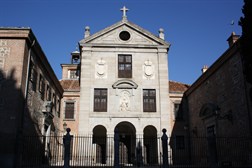Centres of power and spirituality: convents in the Baroque period
 The following itinerary aims to introduce a series of convents which sprang up in Spain in the Baroque period and which have a peculiarity: they were founded by women from courtly society, such as queens, princesses or aristocratic ladies. Most of these buildings were erected near important pious spaces of power, such as the surroundings of the Alcázar of Madrid or the Chancillería RealThe Chancillería Real (Royal Chancellery) was the main judicial body that had jurisdiction over Castile. Created in the fourteenth century in a general reform of justice in the kingdom, it lasted until its suppression in the nineteenth century. Its main function was to receive and resolve all the open court cases in the kingdom of Castile, and to validate official documents with the royal seal, without making them pass through the hands of the king. It lost prominence in the sixteenth century, when the Chancillería de Granada was created. (Royal Chancellery) of Valladolid. Today they are small jewels of the Spanish Baroque, of great artistic value which are essential for understanding the daily lives of the queens or the Spanish ladies who professed in these convents during the seventeenth century. These women lived, for most of the time, on a spiritual level. While a good king or a aristocrat was required to devote his time to the government and earthly matters, the queen and her ladies had to focus on divine matters, to display devotion, visit convents, pray for people and other pious works. With the intention of bringing to the Spanish court the kind of spirituality that they practiced, these women from privileged backgrounds founded convents where a good number of women of the court, including the royal family, ended up taking vows. The power exercised through these convents was reflected in informal meetings held there, away from the Palace, held with ambassadors, papal representatives and ministers of the king. The sober façade of the convents, in Baroque style, might suggest that the cloistered spaces were characterized by great austerity and humility, but the reality was quite different. They were, in fact, authentic miniature palaces, beautifully decorated with splendid frescoes on ceilings and walls and unique collections of portraits, tapestries and jewelery.
The following itinerary aims to introduce a series of convents which sprang up in Spain in the Baroque period and which have a peculiarity: they were founded by women from courtly society, such as queens, princesses or aristocratic ladies. Most of these buildings were erected near important pious spaces of power, such as the surroundings of the Alcázar of Madrid or the Chancillería RealThe Chancillería Real (Royal Chancellery) was the main judicial body that had jurisdiction over Castile. Created in the fourteenth century in a general reform of justice in the kingdom, it lasted until its suppression in the nineteenth century. Its main function was to receive and resolve all the open court cases in the kingdom of Castile, and to validate official documents with the royal seal, without making them pass through the hands of the king. It lost prominence in the sixteenth century, when the Chancillería de Granada was created. (Royal Chancellery) of Valladolid. Today they are small jewels of the Spanish Baroque, of great artistic value which are essential for understanding the daily lives of the queens or the Spanish ladies who professed in these convents during the seventeenth century. These women lived, for most of the time, on a spiritual level. While a good king or a aristocrat was required to devote his time to the government and earthly matters, the queen and her ladies had to focus on divine matters, to display devotion, visit convents, pray for people and other pious works. With the intention of bringing to the Spanish court the kind of spirituality that they practiced, these women from privileged backgrounds founded convents where a good number of women of the court, including the royal family, ended up taking vows. The power exercised through these convents was reflected in informal meetings held there, away from the Palace, held with ambassadors, papal representatives and ministers of the king. The sober façade of the convents, in Baroque style, might suggest that the cloistered spaces were characterized by great austerity and humility, but the reality was quite different. They were, in fact, authentic miniature palaces, beautifully decorated with splendid frescoes on ceilings and walls and unique collections of portraits, tapestries and jewelery.
